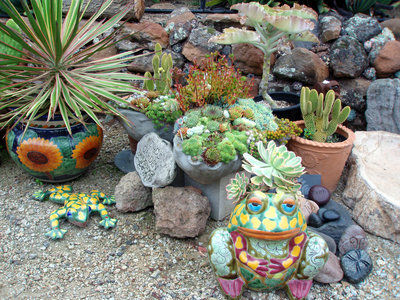Fresh from a day spent in the spectacular world of succulents, I’m excited about using these unique plants in new ways.
Succulent Gardens in Moss Landing recently hosted a day of speakers, tours and demonstrations showcasing these fabulous, unearthly-looking plants. I’ve always liked succulents grown along a walkway, around accent boulders or tucked between perennials. Now I’m creating awesome vignettes in containers that I can move under an overhang to protect them from excess rainfall and frost, if necessary.
There are so many impressive varieties to choose from. Here are some of my favorites that I enjoyed on the tour.
Aeonium
Many showy succulents need only a bit of protection during our winters. Aeonium decorum “Sunburst” is one of the showiest species, with spectacular variegated cream and green 10-inch rosettes. This plant grows 2 feet tall and looks terrific with black “Voodoo” aeonium in a pot.
Sunburst is hardy to 28 degrees, while Voodoo will survive down to 32 degrees. Aeoniums do so well in our climate as they come from Arabia, East Africa and the Canary Islands, where winter rainfall is the norm.
Aeoniums propagated from tissue culture are now affordable. There was a time when a 2-inch seedling cost upward of $100. Tissue culture involves taking cells from the core of the plant and growing them in a sterile medium, such as agar. The resulting plants are exact copies of the mother plant and mature quickly.
Echeveria
These plants grow naturally in higher elevations of central Mexico to northwestern South America and so do well in our cool, wet winters. “After Glow” is frost tolerant and seems to be painted with fluorescent paint. There are spectacular hybrids being developed every year. These are not as hardy as the traditional hens-and-chicks, but they are well worth the effort to find a place where they can survive a freeze. Frilly “Mauna Loa” sports turquoise and burgundy foliage while “Blue Curls” looks like an anemone in a tide pool.
Aloe
Aloes from South Africa and Arabia are old-world plants. Many, like the medicinal aloe vera, are frost tender, but some, like the tree-like Aloe plicatilis, are hardy down to 25 degrees and look great either in the garden or in pots.
Did you know the Egyptians used aloe in the mummification process, or that there are no known wild populations of aloe? In South Africa, an aloe called ferox is used in the same way as aloe vera for burns and stomach problems. This variety is hardy down to 20 degrees and blooms in January.
Container planting
When potting succulents in containers, be sure to use a quality potting mix, as good drainage is essential. There are special succulent mixes available, but succulents are forgiving, as long as the soil drains freely.
A great tip I got from Debra Baldwin, author of “Designing with Succulents” and “Succulent Container Gardens,” is to add Dry Stall to regular potting soil. Dry Stall is a horse bedding product made with pumice. It is similar to perlite, although heavier and less expensive.
Her recipe for succulent soil mix differs with the size of the leaf. For fat, juicy leaves, use 75 to 90 percent pumice or perlite to potting soil. Fine-leaved varieties thrive in a soil mix of 25 percent pumice to 75 percent soil, and all the rest get a mixture of 50-50. Don’t add gravel or clay shards at the bottom if planting in a container as this impedes drainage. It works best to fill the entire pot with soil, top to bottom.
Because succulents use little water, they are easy to care for. If you hate the idea of having to water after you get home from work, create the garden of your dreams with succulents.
Jan Nelson, a landscape designer and California certified nursery professional at Plant Works in Ben Lomond, will answer questions about gardening in the Santa Cruz Mountains. E-mail her at ja******@*ol.com, or visit www.jannelsonlandscapedesign.com to view past columns and pictures.












